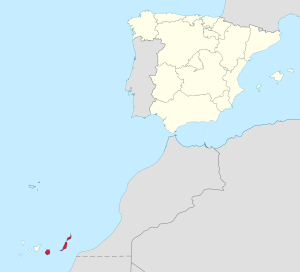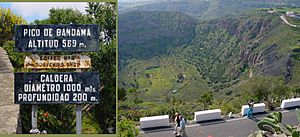Province of Las Palmas facts for kids
Quick facts for kids
Las Palmas
Provincia de Las Palmas
|
|||
|---|---|---|---|
|
|||

Map of Spain with Las Palmas highlighted
|
|||
| Country | Spain | ||
| Autonomous community | Canary Islands | ||
| Capital | Las Palmas de Gran Canaria | ||
| Area | |||
| • Total | 4,066 km2 (1,570 sq mi) | ||
| Area rank | Ranked 46th | ||
| Population
(2018)
|
|||
| • Total | 1,109,175 | ||
| • Rank | Ranked 12th | ||
| • Density | 272.79/km2 (706.53/sq mi) | ||
| Official language(s) | Spanish | ||
| Parliament | Cortes Generales | ||
The Province of Las Palmas (Spanish: Provincia de Las Palmas) is a province in Spain. It forms the eastern part of the Canary Islands, which is an autonomous community of Spain. This means it has its own government, but is still part of Spain.
The capital city of the province is Las Palmas de Gran Canaria. This city is located on the island of Gran Canaria. The province is known for its beautiful beaches, volcanic landscapes, and warm climate.
Contents
Discovering Las Palmas Province
The Province of Las Palmas is one of two provinces that make up the Canary Islands. It includes several islands in the Atlantic Ocean. These islands are located off the northwest coast of Africa.
Main Islands of the Province
The province is made up of three larger islands and several smaller ones. Each island has its own unique features.
Gran Canaria: A Miniature Continent
Gran Canaria is the most populated island in the province. It is often called a "miniature continent." This is because it has many different landscapes. You can find golden sand dunes, green forests, and rugged mountains. The capital city, Las Palmas de Gran Canaria, is a busy port and a popular tourist spot. It has a long city beach called Las Canteras.
Fuerteventura: The Beach Paradise
Fuerteventura is the second largest island. It is famous for its long, white sandy beaches and clear turquoise waters. It is a great place for water sports like windsurfing and kitesurfing. The island's landscape is mostly flat and desert-like. It has many ancient volcanoes.
Lanzarote: The Volcanic Wonderland
Lanzarote is known for its unique volcanic landscapes. Much of the island is covered in black lava fields. These were formed by volcanic eruptions centuries ago. Timanfaya National Park is a must-see. Here, you can see geothermal heat coming from the ground. The island also has beautiful white villages and vineyards.
Smaller Islands and Islets
The province also includes smaller islands. These are La Graciosa, Alegranza, Montaña Clara, Roque del Este, and Roque del Oeste. La Graciosa is the only one with a small population. These smaller islands are mostly nature reserves. They are important for protecting rare plants and animals.
A Brief History of the Province
The history of the Province of Las Palmas is linked to the history of the Canary Islands. The islands were first settled by indigenous people. Later, they became part of Spain.
The Province's Creation in 1927
For a long time, all the Canary Islands were part of one single province. This was called the Province of Canary Islands. However, in 1927, this large province was split into two. This created the Province of Las Palmas and the Province of Santa Cruz de Tenerife. This split helped manage the islands better.
Becoming an Autonomous Community
In 1982, both provinces became part of something new. They joined together to form the Canary Islands autonomous community. This means the Canary Islands now have their own regional government. This government makes many decisions for the islands. It helps them manage their own affairs.
Population and Culture
The Province of Las Palmas is home to over a million people. Most of them live on Gran Canaria. The culture here is a mix of Spanish and unique Canarian traditions.
Language and Traditions
The official language is Spanish. However, people in the Canary Islands have their own accent and some unique words. Festivals are very important. The Carnival of Las Palmas de Gran Canaria is one of the biggest and most colorful. Music and dance are also a big part of the local culture.
Economy and Tourism
Tourism is a very important part of the economy. Millions of visitors come each year. They enjoy the beaches, climate, and natural beauty. Agriculture is also important, especially growing bananas and tomatoes. Fishing is another traditional activity.
Images for kids
See also
 In Spanish: Provincia de Las Palmas para niños
In Spanish: Provincia de Las Palmas para niños







